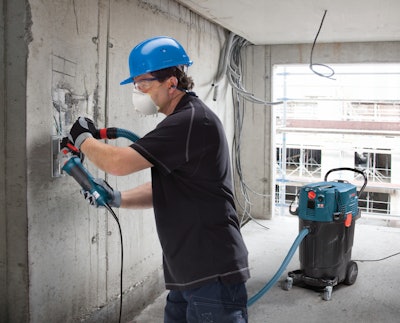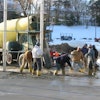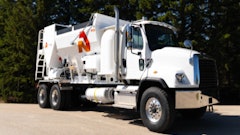
The OSHA regulation outlining requirements for exposure to respirable silica dust has been in place for months. But not every organization has taken the steps necessary to meet the guidelines. This is a reminder that every company that works with concrete, stone or other masonry materials must meet the OSHA requirements.
1. What if you’re working in a small area where the dust suction attachment won’t fit?
If the tools identified in Table 1 cannot be used as noted in Table 1 or the employer cannot fully and properly implement controls and protections described in Table 1 controls, then “Alternative exposure control methods” must be established as specified in paragraph D. This will require the employer to conduct independent testing or provide objective data and specifically document exposure levels and what steps a worker must take to stay below the Permissible Exposure Limit (PEL) (0.5µg/m3: 50 micrograms per cubic meter) over a time-weighted eight-hour day.
2. Can you use tools from one brand and an attachment from a different brand?
We’re talking about the actual dust collection attachments that fit directly onto power tools, such as drilling attachments that fit onto rotary hammers or surface grinding shrouds; cutting guards that fit directly onto small or large angle grinders. These types of attachments have specific mounting collars and/or clamping bands that make them dedicated to their specific tool for their specific brand. In these situations tools from one brand cannot be used with attachments from another brand.
There are also dust collection attachments that can fit a variety of brands such as chiseling and demolition attachments for SDS-max®, Spline or 1-1/8 In. breaker hammers. Finally, there are a few dust collection attachments that are independent of the tool. An example of these types of attachments would be wall suction units for large diameter drilling in concrete. These attachments use the suction power from the dust extractor to be secured to the wall or work surface. Please refer to the manufacturer’s instructions for the actual use of these attachments.
Regardless of the combination of tool, attachment (and/or brand) being used, the system chosen can be used as long as they meet the OSHA PEL (0.5µg/m3: 50 micrograms per cubic meter) over a time-weighted eight-hour day. Many power tool companies provide objective data sheets that are valid only for the specific tool combination(s) tested. When using such objective data sheets to show compliance employers users need to ensure use of the exact tool combination shown in the data sheets.
3. Can a dust extractor (vacuum) from one brand be used with another brand of tools and attachments?
Yes, but the configuration must meet Table 1 specifications. For example, when using a grinder the user needs to be sure that the vacuum is capable of providing a minimum of 25 CFM (cubic feet per minute) per 1" of grinder wheel, the vacuum has a filter cleaning system (automatic or semi-automatic) and the filter has 99% efficiency (HEPA is preferred). Always be sure to use the vacuum according to instructions provided by its manufacturer.
4. What is the proper collection procedure for concrete dust?
Use of a fleece bag is highly recommended. These are usually multi-ply fabric bags that help manage air equilibrium in the vacuum and collect .3 microns or larger dust particles. It also contains a port-closing mechanism for dust containment after removing the bag from the vacuum canister’s port. Finally, fleece bags are strong enough to withstand the weight of dust collected and is more resistant to tearing than paper bags.
5. Will there be a special place for users to dispose of a full dust collection bag separate from a regular dumpster?
Collected silica dust can be disposed of in a regular dumpster after taking special precautions to properly contain it and avoid any leaks. Users can simply take the vacuum collection bag that’s about 80% full and place it in a standard garbage dumpster. Be careful that it’s not going to be exposed to potential damage if other items are placed in the same dumpster on top of it.
6. Are HEPA filers required in Table 1?
7. Is there a limit for length of a vacuum hose?
The longer the hose, the greater the decrease in the dust extractor’s ability to collect dust. It is recommended to use the shortest hose length practical for a given job and to always follow directions of the dust extractor manufacturer. Bosch dust extractors can be used with either a 10 Ft. hose (which comes with the unit) or with a 16 Ft. hose (sold separately).
8. What about jobsite dust from surrounding work areas? How can this be distinguished from cutting/grinding operations?
At many jobsites, there can be more than one contractor or more than one subcontractor working at any given time that may be creating airborne dust and/or silica dust. In addition, there can be another construction site lose by that also can influence the exposure levels of these airborne particles. The OSHA Silica Dust Regulation states that construction companies must reduce their employees’ exposure to silica dust to meet the PEL (permissible exposure limit). See OSHA Silica Dust Regulation for details. This means that the applications identified in the Regulation must be controlled (per OSHA Silica Table 1) and that the construction companies must have a work plan that takes into consideration airborne silica dust created from the surrounding work areas, including construction sites nearby.
Ed. Note: All information cited was prepared by Robert Bosch Tool Corporation on December 1, 2018, which is to serve as a basic summary helping users generally understand the OSHA Respirable Crystalline Silica Rule for the construction industry. This is not an official, legal, safety-related or comprehensive interpretation of the rule; you should always rely on your own review and evaluation of the applicable rules and regulations and understand that it is the individual’s and/or employer’s obligation to comply with such rules. Also, there may be additional OSHA standards and OSHA-approved state programs that apply. When using the equipment shown in this guide as you strive to meet your required compliances, always use the tools in accordance with the owner’s manual and OSHA regulations. For official information, please go to https://www.osha.gov/silica/ and for the complete rule (including Table 1), please see https://www.osha.gov/silica/SilicaConstructionRegText.pdf.










![Fcp Racatac Chair 10893876[1]](https://img.forconstructionpros.com/mindful/acbm/workspaces/default/uploads/2025/10/fcp-racatac-chair-108938761.10l0At5WXv.png?ar=16%3A9&auto=format%2Ccompress&bg=fff&fill-color=fff&fit=fill&h=135&q=70&w=240)








